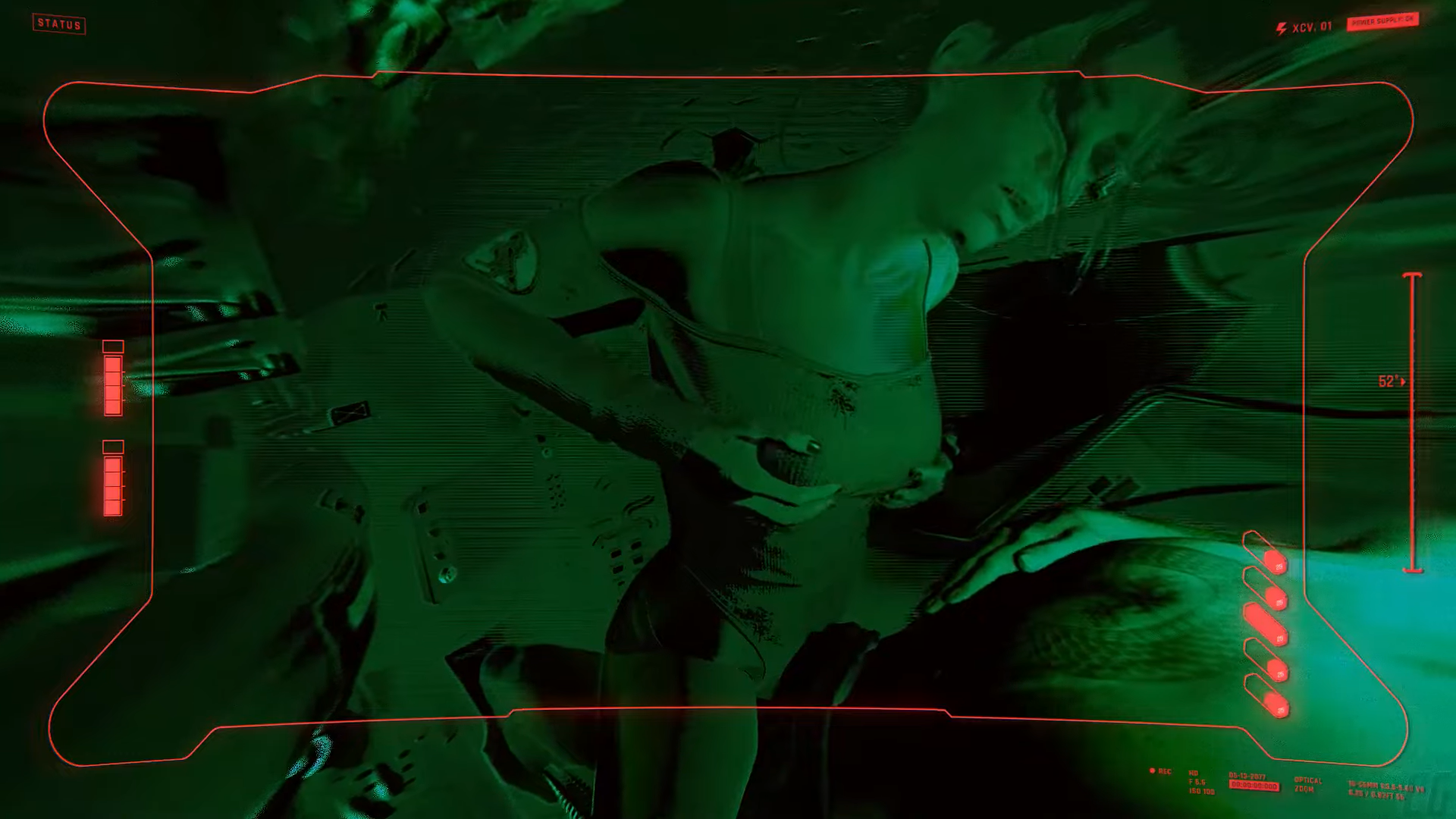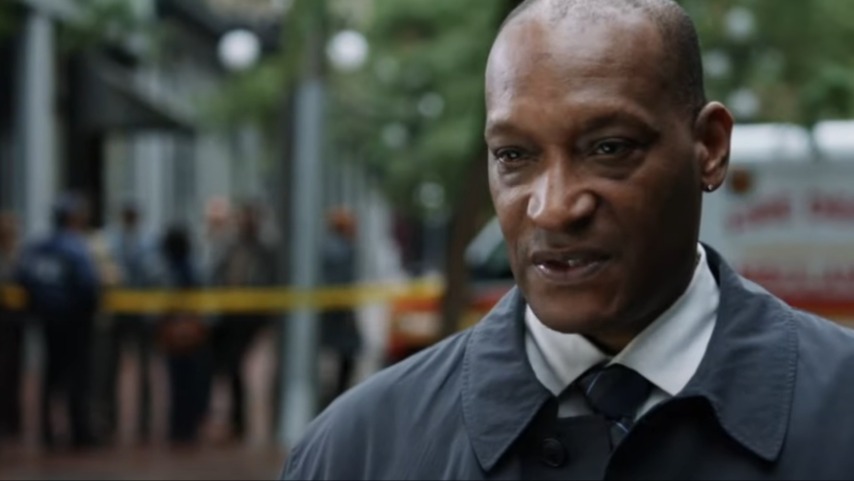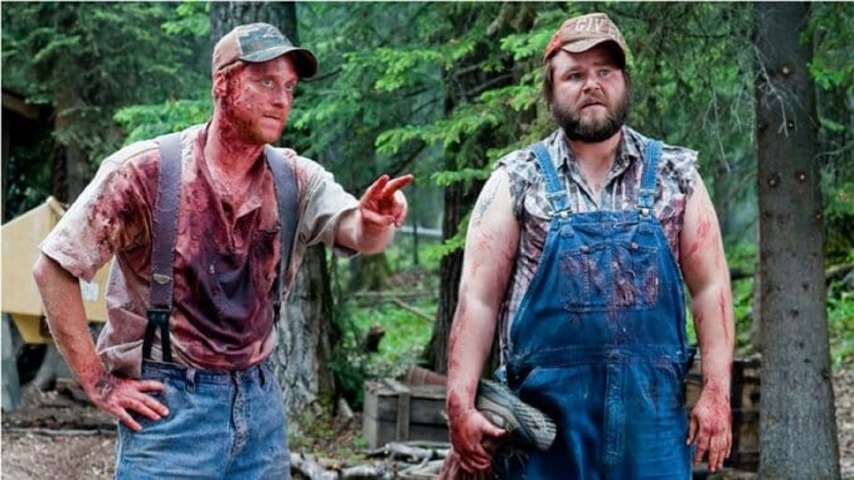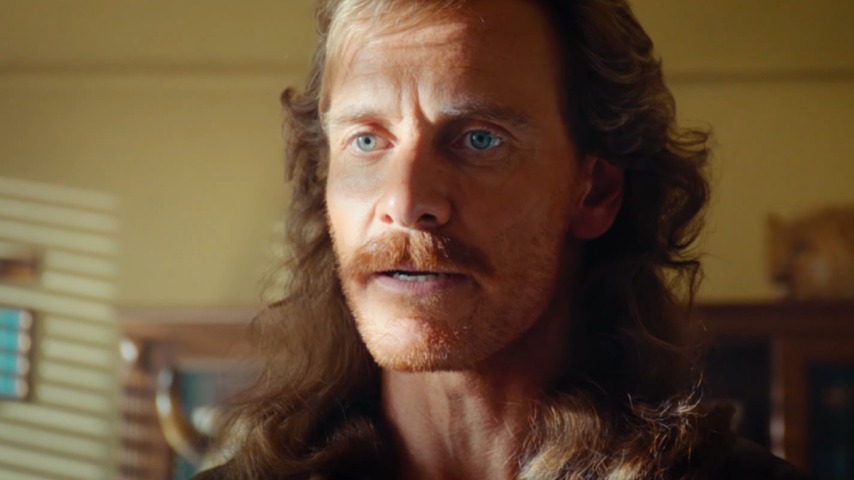
Somewhere in Warsaw, Poland, two actors are pretending to have sex. It’s not the most intimate of environments. The mood lighting, if you can call it that, is fluorescent bulbs burning overhead, making the sterile, white walls look even brighter than they actually are. In lieu of a bed or couch, the actors fit tightly into a makeshift tank—a technical mockup that's more pipes and bars than any sort of vehicle—to capture an intimate scene between Cyberpunk 2077 mercenaries V and Panam Palmer.
The actors are wearing stretchy black one piece bodysuits designed for motion capture scenes—something not dissimilar from a diving wetsuit—adorned with velcro markers strategically placed all over their bodies. Sometimes, when the velcro bits touch, you can hear the riiiiip of the actors getting stuck—and unstuck—from each other as they climb back-and-forth between seats and each other.
“When there’s too much contact, the markers on mo-cap suits start to fall off and break,” CD Projekt Red creative director Igor Sarzyński told me. “It’s really difficult to both create an authentic, intimate atmosphere between the actors and get something through in this performance in this very technical setup. It’s complex and sometimes a little bit awkward.”
"Sex is a huge part of life, and it feels strange when art ignores that."
Sex is often playful, and it’s no wonder why it’s been a consistent theme in video games for as long as the industry has existed—and that’s despite sex occupying “an uncomfortable space within the medium of video games,” as Ashley ML Guajardo (née Brown) put it in her book Videogames and Sex. “There is discomfort regarding the representation and treatment of sex as something playful.” There were quite a few games with erotic themes published in the 1980s, be it on the Apple II system (Softporn Adventure) or Atari (X-Man). These games remained largely on the fringe for decades, and sex in games was largely relegated to pornography or for humor, like in the crude Leisure Suit Larry series. In 2004, Rockstar Games published Grand Theft Auto: San Andreas, a game infamous for a removed mini-game—dubbed Hot Coffee—that was discovered in the game’s code; that mini-game let players control protagonist Carl Johnson as he fucks his girlfriend. Though Rockstar Games came under fire for that discovery, sex has stayed a constant theme in video games throughout the 2000s, be it for conquest, laughs, storytelling, or pleasure.

What has changed, though, is the approach to putting sexual content in video games. There has never been a shortage of sexualization—specifically of women—in video games, but in more recent years, there’s been a push to explore sex and romance as part of a game’s narrative. Sony Interactive Entertainment’s God of War (2005) is one of the earlier 3D games to step away from the suggestive fade-to-black technique and allow for nudity; though the actions themselves aren’t shown, God of War does show several topless women, then pivots the camera as the player hits a button while the women moan. The scene itself can certainly be seen as the sexualization of women, but it’s also aligned with protagonist Kratos’ desire for conquest. Mass Effect and The Witcher, too, are to be credited, too, for the evolution of sex as a narrative element, even if it’s not always successful.
“Sex adds a more human element to a story,” adult visual novel and sex game Come Home developer RJ Rhodes told me. “It makes everything more relatable. Sex is a huge part of life, and it feels strange when art ignores that. Games like Mass Effect, The Witcher, Baldur's Gate 3 all benefited from having sex in the game. It would be weird if these characters in those games — adults who spent a lot of time together and had good chemistry and in some cases loved each other."
The game development process has changed dramatically over the past several decades, and developers have had to fumble through how sex is portrayed, too. The crude avatars of Grand Theft Auto bumping their parts together are no longer the norm; studios use motion capture to perfect their animations — even sex.
The video game industry is still working out the norms of intimate motion capture, and some motion capture performers are looking for better protections, like intimacy coordination, on set. In 2024, casting director and motion capture performer Jessica Jefferies told the BBC that it’s been common to show up to set with no warning of what was to be filmed. As part of the Equity union, she’s looking for game developers to agree to increased transparency and intimacy coordination on set. “Essentially, [intimacy coordinators] work with directors and producers on a production to help support actors, but not only actors — crew, anybody involved — in the creating of scenes of a sexual nature, or sensitive scenes or hyper-exposing scenes and advocate for them, so we’re working in the most comfortable and safe way possible,” movement and intimacy director Asha Jennings-Grant told me.
The use of intimacy coordinators is growing on film and TV sets. It's still new for video games; Baldur’s Gate 3 is likely the first company to employ intimacy coordinators for its voice and motion capture performers in an animated video game. (Game designer Sam Barlow hired an intimacy coordinator for the live-action sex scenes in Immortality.) Jennings-Grant worked on Baldur’s Gate 3 first as a performance director before moving into the intimacy coordinator role specifically on scenes with dialogue, where the actors were captured just from the waist up. “We’re only capturing quite nuanced and small movements for those dialogue scenes,” Jennings-Grant said. This footage would then be used as reference to create the moments before and after the sex scenes in Baldur’s Gate 3 — so, for instance, the flirty dialogue between Halsin and Astarion that leads to the infamous bear encounter.
“It allows time and space for intimacy and intimacy in performance,” Jennings-Grant said. “In my experience of being in these creative spaces, sometimes it’s overlooked and not thought about in as much detail as other aspects of the performance. It allows people to discuss it. It allows people to just think about, How is it part of the storytelling? What are we going to do to strengthen that or to really support these kinds of narrative moments?”
Though neither The Witcher 3 nor Cyberpunk 2077 used an intimacy coordinator, developer CD Projekt Red is thinking about how sex impacts their games; not only how to create mood and intimacy in brightly-lit motion capture stages while covered in velcro balls, but also how sex influences both the game’s world and the real world. CD Projekt Red senior writer and Cyberpunk 2077 story coordinator Magdalena Zych told me that the company (which is based in Poland) was making Cyberpunk 2077 during a time where several Polish municipalities were declaring themselves as “LGBT-free zones,” where LBTQ events and marches were unwelcome. The Witcher 3 had only straight relationships and sexual encounters — “[Geralt] is quite a sexual creature,” Zych said — while Cyberpunk 2077 had the chance to do something different. Cyberpunk 2077 has a playable character that can have different body parts and different genders, but you can’t just romance anyone; it’s an intentional approach to showing not only straight and bisexual characters, but gay ones, too. (CD Projekt Red has been both criticized and praised for its characterization of both trans and queer characters.) Judy, for instance, is specifically a lesbian woman, and only female characters can romance and have sex with her.
“I do get also why this question [of having romance and sex in games] even arises because in some games sometimes it may feel like those things are added there just for the sake of having a sex scene,” Zych said. “It feels like, okay, you completed a level, so now as a reward you get to experience this bit of different type of action. But with our games, I feel like not having sex scenes by design at all, shying away from that, would also be a decision that would require some kind of justification.”
CD Projekt Red creative director Sarzyński added that sex is baked into Cyberpunk 2077’s larger world. Everything is “commodified to the extreme,” even bodies and sex. The sex scenes in the game both are influenced by that commodification and in defiance of it, depending on the situation. “This allows us to create this tension or more storytelling spectrum between how the world is and then what can happen between two people who find true emotions between each other,” he said.
The sex in Cyberpunk 2077 had to add something to the game, to allow the player to better understand its characters.
“It's like when humans are the most raw and open in a way,” Sarzyński said. “With sex scenes, we tried to capture the true essence of each character you're interacting with. After peeling off all those layers of initial distance, getting to know each other better, what does it mean when the characters can now fully express themselves?”
The development and writing process is different for every video game studio. Zych said CD Projekt Red started to play Cyberpunk 2077’s plot in the “very early stages of pre-production,” thinking about both the main characters and side characters in the world. It’s broad, so granular details — like sex scenes — don’t come in until down the road.
“And then the more granular it gets during production, we think of how we want to stage [dialogue],” she said. “Usually we just want to deepen the characterization of a specific NPC with the sex scene. For example, with Judy, she's the brain dance specialist. We knew very early that we wanted to involve the brain dance in some way. We wanted this scene to be very delicate and intimate, not because Judy is a woman, but because she was in a very vulnerable state at that time.”
Motion capture and dialogue performance can begin once writing is settled. For intimate scenes, this is where someone like Jennings-Grant will come in, connecting all departments and making sure communication is clear and precise. That transparency allows for a safe, creative environment for actors. Mimi Hung, a voice actor and sound designer who describes herself as specializing in “NSFW audio,” told me that voice acting — especially for erotic scenes — can be hard on one’s voice. “This work can really wreck your voice if you're not careful, that's why I have a much higher rate for intense vocal recording,” she said.
Hung, who works largely on sex games like Erokin, which brings in more than $8,000 a month on Patreon, has a home studio where she records dialogue and sex sounds for games and other animation. For a game like Erokin, Hung is sent “mostly complete animations” that she dubs over. “I follow the movements on-screen and make sounds that would match the characters’ bodily and mouth movements,” she said. There’s a big creative and technical element to it, too; Hung has a library of sex sounds to pull from to be able to fill in the noises that go along with moans and other vocal sounds.
“It's like being a toddler again exploring different sensory toys,” Hung said. "I need something wet here, but something with no impact or, I need something with a really hard impact with a really slippery in-and-out sound. I used my hands and lotion or shaving cream to get most of my noises. Something thick and viscous helps create more audible noises that help bring an animation to life, compared to a thinner liquid that might sound more realistic but aren't as effective.”
Oranges, she said, are usual for certain scenes involving fingers. “They're incredibly juicy fruits, so it's just a matter of sticking my finger into a slice and desecrating the poor thing,” she said. “It's really handy in those situations to have a bowl of water and towels nearby before touching equipment. Wouldn't want ants around that expensive stuff.”
Alex Jordan, who plays Rook in Dragon Age: The Veilguard and Mr. Hands in Cyberpunk 2077’s Phantom Liberty expansion, was brought on to Baldur’s Gate 3 specifically for sex sounds, he said on TikTok in 2023. “It was very awkward,” he said. “I made sounds like mmm and ahhh, and then I kissed my hand a whole lot. You think about that. You mull that over as you run around, you little horny perverts with your little perverted roleplays. You randy bastards. You think of me.”
Sound designers have a really important role to play in these scenarios. “Foley is such an excellent tool to bring things to life and to make them haptic through sound,” video game foley artist Almut Schwacke told me. “When you see people being intimate in the cinema, you would hear all the skin and touching noises and kissing and whatever is happening between the bodies that are involved. It plays the exact same role [in video games.]”
The sound of skin touching can be so subtle it makes kissing particularly challenging. “You just caress yourself in front of the microphone,” Schwacke said. “That's pretty much it. And if it's kisses needed, you're kissing your own hand or arm or whatever, and look for what sounds best. But especially skin can be a bit tricky because for it to make enough sound, you sometimes need to do more than what you see on screen.” Add a hairpiece if you’re recording someone with a beard, Schwacke said, laughing.
Motion capture footage is often used as reference for animations in video games. CD Projekt Red opted to use a first-person camera for its sex scenes in Cyberpunk 2077 as a way to make players feel more enmeshed in a moment. The perspective shifts at times, just to spice up scenes and keep things from getting repetitive, but the first-person perspective is an intentional choice. “For us on Cyberpunk, creating this constant feeling of immersion in your character’s body all throughout, without cuts [was important]” Sarzyński said.
But the team had to use camera tricks to keep things looking normal. Sarzyński said the trick they used in sex scenes was that the camera wasn’t placed exactly where a character’s head would be. Instead, they pushed it out a meter behind where it should be and used a longer field-of-view with a pushed in zoom. That kept faces from getting distorted, which can happen with a wider camera lens. But the actual animation choreography itself isn’t too different from complex fight scenes. Fight scenes are a good comparison, Sarzyński said. “A lot of body contact, one body affecting another, plus on top of that, you have scenes that are recorded separately, so we’re trying to connect them.”
Sarzyński said, though, that sex and romance scenes in Cyberpunk 2077 require the highest fidelity from an animation standpoint. They involve a lot of delicate parts, like fingers and lips. “It’s not some rough right when someone punches someone and you don’t see what happens because it’s happening so fast,” he said. “You really need to be very precise with it.” Sarzyński described a problem with players customizing their fingernails to be too long, but the long fingernails were messing up a scene with Judy, where long nails were clipping into her skin. They create a variant of character models specifically for delicate scenes like this to address the nail problem, either defaulting nails — for that moment — to a specific length or playing with camera angles to prevent those issues entirely.
"There's only so many words that you can use to describe a cock."
Beyond customization in avatars, however, Cyberpunk 2077 doesn't offer players a lot of interactivity within sex scenes, and that’s by design. Players have a choice, of course, on how their character interactions go, and they can accept or decline an advance. Zych described CD Projekt Red’s “unwritten but pretty strong rule” that storytelling overrules player choice in critical moments. It allows for Zych and her team to craft these moments for the highest emotional impact.
Sarzyński added that mechanical input in sex scenes—like button pushes to touch here or there — could push the game into porn territory, positing that player agency in these situations takes away from the narrative importance of something. The player doesn't need to be an active participant in the sex scene, he suggested. Heavy Rain infamously added quicktime button pushes into its sex scene to do things like have Ethan unzip Madison's pants or unhook her bra, and it didn’t go over well—not because it was pornographic, but because it was awkward. (That's not to mention that the scene happened immediately after Ethan chopped off his own finger. Quantic Dream declined to comment for this story.
An interactive approach may not be appropriate for a game like Cyberpunk 2077, but it’s more normalized in games that are designed, explicitly, as sex games or porn. Rhodes told me that player agency —deciding a position, for instance—helps a player insert themselves further into the fantasy. “It’s less passive” than a cutscene, she said.
This active participation is crucial for games in this genre, especially when 3D models may not totally get the job done. Rhodes says she uses pre-made 3D elements that she edits, but finding the right assets isn’t easy. Come Home’s cutscenes, for instance, are largely static scenes with minimal movement. But there are options across the game, which includes more than 20 date-and-fuck-able love interests, to manipulate scenes; in one scene, where the main character is having sex with his college professor (while her husband watches), the player can choose the position. In another scene, in which the main character gets spicy with his boss, you decide whether you want to be submissive or not.
When players and critics ask the question, Did this game even need romance or sex?, the answer is largely personal to the person playing it. Some people will never want that sort of content in their games, and some people will seek out games specifically to get off. But if we’re talking about whether a sex scene is additive to any one experience, it starts with the challenge of good writing — “There's only so many words that you can use to describe a cock,” Rhodes quipped—and good writing translates into good acting and animation. So many big and small details have to be so precisely placed, and even then, it might not land.
But the scenes that do land, where everything is right, can make a difference in video game storytelling. They just need the space to work, the space to create something “truthful to the narrative and storytelling of it,” as Jennings-Grant said.
“It’s love, it’s intimacy, it’s trust, it’s safety,” Sarzyński said. “But sometimes it’s also desire and physical touch. And when telling, at least, our stories, we don’t want to pretend it’s not there.”
And, if you do, your players might just patch it in anyway.








